tire pressure Oldsmobile Cutlass Supreme 1996 Owner's Manuals
[x] Cancel search | Manufacturer: OLDSMOBILE, Model Year: 1996, Model line: Cutlass Supreme, Model: Oldsmobile Cutlass Supreme 1996Pages: 356, PDF Size: 18.48 MB
Page 155 of 356

. .. , " .
- + ;;'i; ' ,Here's how anti-lock works. Let's say the road is 'w&.
t' II ,You're driving safely. Suddenly an admaPjumps out in
. front of you.
i ; You slam on the brakes. Here's what happens with ABS.
-. .
: ..
. A computer senses that wheels are slou4.ing down. If one
I - .' .k. of the wheels is about to stop rolling, the computer will '
; --. 1 . separately' work the brakes at each front whed and at the
..
..., rec wheels.
.. 'I
The anti-lock system can change the hrake pressure .
faster than any-driver'could. The computer is
programmed to make the most of available tire and ' '
road conditions.. ..
i
You can steer around the obstacle while braking hardK$:,
As you brake, your computer kpeps receiving updates on
wheel. speed and controls braJsiig.pressure accordingly.
'., 4-7
Page 165 of 356
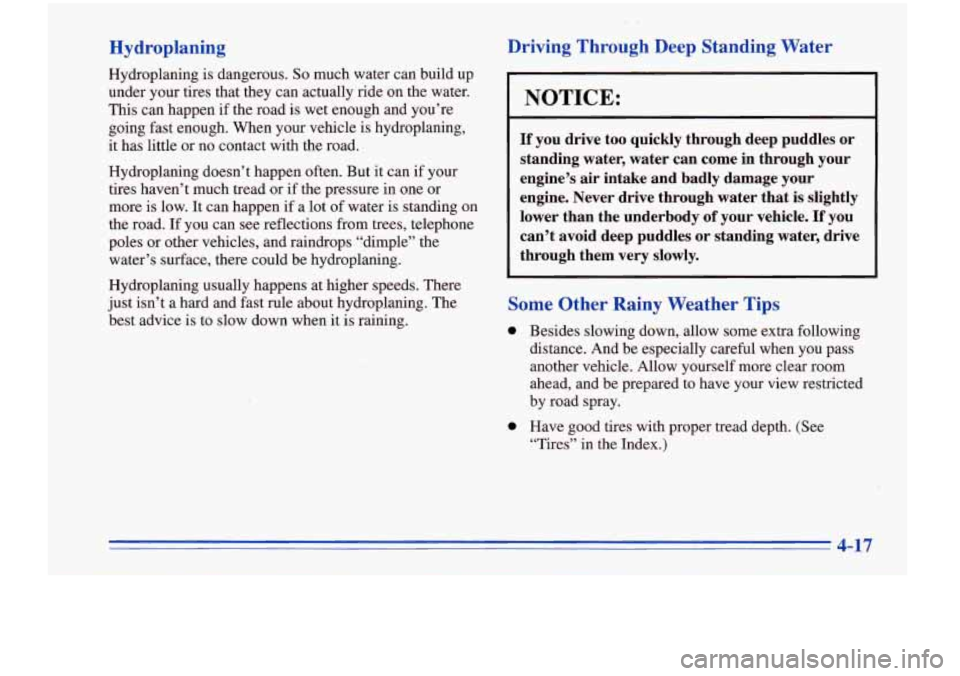
Hydroplaning
Hydroplaning is dangerous. So much water can build up
under your tires that they can actually ride on the water.
This can happen if the road is wet enough and you’re
going fast enough. When your vehicle is hydroplaning,
it has little or no contact with the road.
Hydroplaning doesn’t happen often. But it can if your
tires haven’t much tread or if the pressure in one or
more is low.
It can happen if a lot of water is standing on
the road. If you can see reflections from trees, telephone
poles or other vehicles, and raindrops “dimple” the
water’s surface, there could be hydroplaning.
Hydroplaning usually happens at higher speeds. There
just isn’t a hard and fast rule about hydroplaning. The
best advice is to slow down when it is raining.
1 Driving Through Deep Standing Water
NOTICE:
If you drive too quickly through deep puddles or
standing water, water can come in through your
engine’s air intake and badly damage your
engine. Never drive through water that is slightly
lower than the underbody
of your vehicle. If you
can’t avoid deep puddles or standing water, drive
through them very slowly.
Some Other Rainy Weather Tips
Besides slowing down, allow some extra following
distance. And be especially careful when you pass
another vehicle. Allow yourself more clear room
ahead, and be prepared to have your view restricted
by road spray.
Have good tires with proper tread depth.
(See
“Tires” in the Index.)
4-17
Page 168 of 356
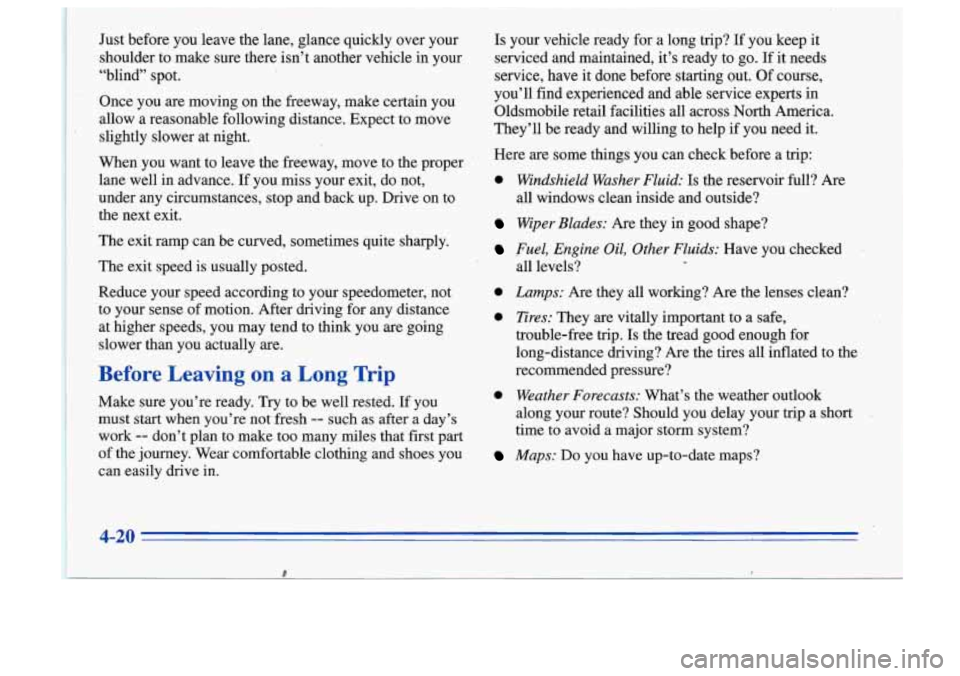
Just before you leave the lane, glance quickly over your
shoulder to make sure there isn’t another vehicle in your
“blind” spot.
Once you are moving on the freeway, make certain you
allow a reasonable following distance. Expect to move
slightly slower at night.
When you want to leave the freeway, move to the proper
lane well in advance.
If you miss your exit, do not,
under any circumstances, stop and back up. Drive on to
the next exit.
The exit ramp can be curved, sometimes quite sharply.
The exit speed is usually posted.
Reduce your speed according to your speedometer, not
to your sense of motion. After driving for any distance
at higher speeds, you may tend to think you
are going
slower than you actually are.
I !
Before Leaving on a Long Trip
Make sure you’re ready. Try to be well rested. If you
must start when you’re not fresh
-- such as after a day’s
work
-- don’t plan to make too many miles that first part
of the journey. Wear comfortable clothing and shoes you
can easily drive in. Is
your vehicle ready for a long trip? If you keep it
serviced and maintained, it’s ready to
go. If it needs
service, have it done before starting out. Of course,
you’ll find experienced and able service experts in Oldsmobile retail facilities all across North America.
They’ll be ready and willing to help if you need it.
Here are some things you can check before
a trip:
0 Windshield Washer Fluid: Is the reservoir full? Are
all windows clean inside and outside?
Wiper Blades: Are they in good shape?
Fuel, Engine Oil, Other Fluids: Have you checked
all levels?
0 Lamps: Are they all working? Are the lenses clean?
0 Tires: They are vitally important to a safe,
trouble-free trip.
Is the tread good enough for
long-distance driving?
Are the tires all inflated to the
recommended pressure?
along your route? Should you delay your trip a short
time to avoid a major storm system?
0 Weather Forecasts: What’s the weather outlook
Maps: Do you have up-to-date maps?
4-20
Page 175 of 356
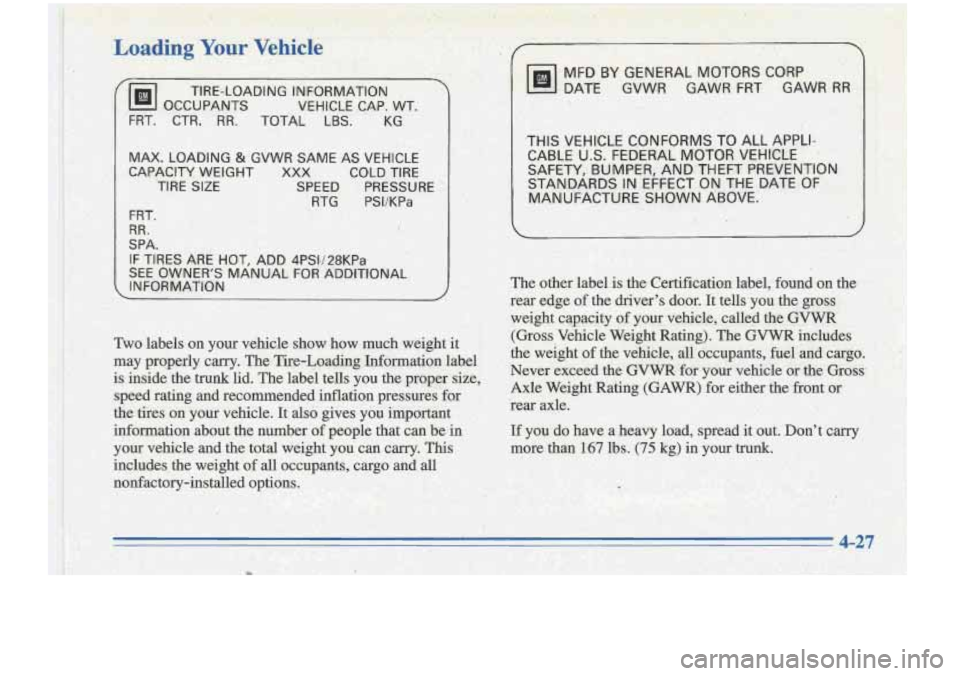
. Loading ' Your' Vehicle
Tm OCCUPANTS VEHICLE .CAP. WT,
TIRE-LOADING INFORMATION
FRT. CTR. RR. TOTAL LBS. KG
MAX. LOADING & GVWR SAME AS VEHICLE
CA.PAClTY WEIG'HT
XXX COLD TIRE
TIRE
SIZE SPEED PRESSURE.
RTG
PSI/KPa
FRT.
RR.
SPA.
IF TIRES ARE HOT, ADD 4PSV28KPa.
SEE OWNER'S MANUAL FOR ADDITIONAL
INFORMATION
i
A
Two labels on your vehicle show how much wei.ght it
may properly carry. The Tire-Loading Information label is inside the
trunk lid. The label tells you the proper size,
speed rating and recommended inflation pressures'for
the tiies on your vehicle. It also gives you important
.
information about the number of people that can be in
your vehicle and the total weight you, can carry. This
includes, the weight 'of all occupants, ,cargo and all
nonfactory-installed options.
r I
mi
I.
MFD'BY GENERAL MOTORS CORP
DATE GVW8 GAWR FRT
. GAWR RR
'THIS VEHICLE C-ONFORMS TO ALL APPLI-
CABLE U.S. FEDERAL
MOTOR VEHICLE
SAFETY, BUMPER, AND THEFT PREVENTION
STANDARDS
IN EF,FECT ON THE DATE Of
MANUFACTURE SHOWN ABOVE.
L 1
The other label is the Certification label, found on the
rear edge
of the driver's door. It tells .you the gross
weight aqacity of your vehicle, called the GVWR
(Gross\Vehicle Weight Rating). The GVWR includes
the weight
of the vehicle, all occupantS, fuel and cargo.
Never: exceed the
GVWR for your vehicie or the Gross
Axle Weight Rating (GAWR) for either, the front or
'rear axle.
If you do have a heavy bad, spread it out. Don't carry
more than 167 lbs. (75 kg) in your trunk:
Page 180 of 356

Total Weight on Your Vehicle’s Tires
Be sure your vehicle’s tires are inflated to the
recommended pressure for cold tires. You’ll find these
numbers on the Tire-Loading Information label (found
inside the
trunk lid) or see “Loading Your Vehicle”
in the Index. Then be sure you don’t go over the
GVW limit for your vehicle, including the weight of
the trailer tongue.
Hitches
It’s important to have the correct hitch equipment.
Crosswinds, large trucks going by and rough roads are a
few reasons why you’ll need the right hitch. Here are
some rules to follow:
0
a
Will you have to make any holes in the body of your
vehicle when you install a trailer hitch? If you do,
then be sure to seal the holes later when you remove
the hitch.
If you don’t seal them, deadly carbon
monoxide
(CO) from your exhaust can get into your
vehicle (see “Carbon Monoxide” in the Index). Dirt
,and water can, too.
The bumpers on your vehicle are not intended for
hitches.
Do not’attach rental hitches or other
bumper-type hitches to them. Use only a
frame-mounted hitch that does not attach to
the bumper.
Safety Chains
You should always attach chains between your vehicle
and your trailer. Cross the safety chains under the tongue
of the trailer
so that the tongue will not drop to the road
if it becomes separated from the hitch. Instructions
about safety chains may be provided by the hitch
manufacturer or by the trailer manufacturer. Follow the
manufacturer’s recommendation for attaching safety
chains and do not attach them to the bumper. Always
leave just enough slack
so you can turn with your rig.
And, never allow safety chains to drag on the ground.
Trailer Brakes
Because you have anti-lock brakes, do not try to tap into
your vehicle’s brake system. If you do, both brake
systems won’t work well, or at all.
Driving with a Trailer
Towing a trailer requires a certaifi amount of experience.
Before setting out for the open road, you’ll want to get
to know your rig. Acquaint yourself with the feel of
handling and braking with the added weight of the
trailer. And always keep in mind that the vehicle you are
driving is now a good deal longer and not nearly as
responsive as your vehicle
is by itself.
Page 217 of 356

Compact
Although the compact spare tire. was fully inflated when
your vehicle was new, it can lose
air after a time. Check
the inflation pressure regularly. It should be
60 psi
(420 Wa).
After installing the compact spare on your vehicle, you
should stop as soon as.possible and make sure your
spare tire
is correctly inflated. The compact sphe is
made to perform well at posted speed limits for
distances up to
3,000 miles (5 000 km), so ydu can
finish your trip and have your full-size tire repaired or
replaced where
you want. Of course, it’s best to replace
your spare w.ith a full-size’tire as soon as you can. Your
spare will last longer and be
in good shape in case you
need it again.
When the ‘compact spare is installed, don’t take
your vehicle through an automatic car wash with
guide rails. The compact spare can get caught
on
the rails. That can damage the tire and wheel,
and maybe other parts
of your vehicle.
. ‘ ~
..
Don’t use your compact spare on other vehicles. ’
And don’t mix your compact spare tire or wheel with
otherwheels or tires. They won’t fit. Keep your sp&e
tire and its wheel together.
-
NOTICE:
Tire chains won’t fit your compact spare. Using
them can damage your vehicle and can damage
the chains too.
Don’t use tire chains on your
compact spare.
.. .. ,
Page 262 of 356

' We don't make tires. Your new Oldsmobile comes with
high-quality tires made
by a leading tire manufacturer.
If
you ever have questions about your tire warranty and'
where to obtain service, see your ;Oldsmobile Warranty.
booklet for details..
Poorly maintained and,jmpbpe$ly used tires '
..are dangerous..
'0 0verloading.your tires can awe ' I
-. You codd have an aimut and a serious
accident. See "Loading Your Vehicle" in
the Index.
.. , 7' 1.
' Nov&heating as a result oft& much.friction. .. I_
CAUTION: (Continued)
0
0
Underinflated tires pose the.same danger as
overloaded tires. The resulting accident
could cause serious injury. Check
all .tires '
'frequently to maintain the recommended
pressure. Tire press& .should be checked
'.
when your tires are cold.
Overinflated tires are more likely to be
cut, punctured or broken by
a sudden
impact
-- such as when you hit a pothole.
Keep tires
at the recommended pressure.
Worn, old. tires can cause accidents. If your
tread is badly worn, or
if your tires have
,been damaged, replace them. ,.
Page 263 of 356
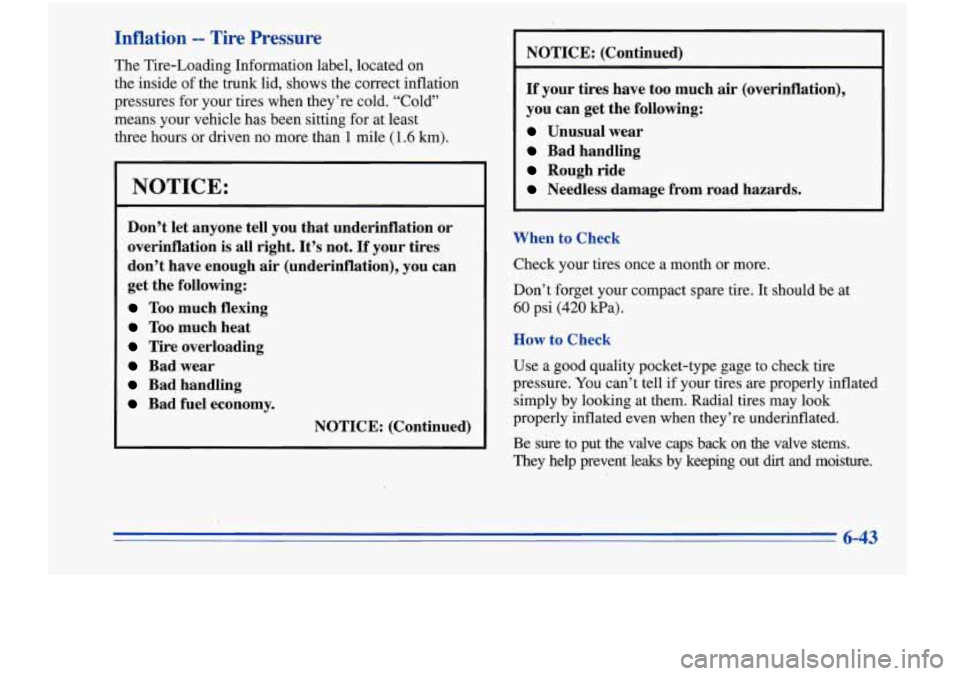
Inflation -- Tire Pressure
The Tire-Loading Information label, located on
the inside of the trunk lid, shows the correct inflation
pressures for your tires when they’re cold. “Cold”
means your vehicle has been sitting for at least
three hours or driven no more than
1 mile (1.6 km).
NOTICE:
Don’t let anyone tell you that underinflation or
overinflation is all right.
It’s not. If your tires
don’t have enough
air (underinflation), you can
get the following:
Too much flexing
Too much heat
Tire overloading
Bad wear
Bad handling
Bad fuel economy.
NOTICE: (Continued) NOTICE: (Continued)
If your tires have too much
air (overinflation),
you can get the following:
Unusual wear
Bad handling
Rough ride
Needless damage from road hazards.
When to Check
Check your tires once a month or more.
Don’t ‘forget your compact spare tire. It should be at
60 psi (420 kPa).
How to Check
Use a good quality pocket-type gage to check tire
pressure. You can’t tell
if your tires are properly inflated
simply by looking at them. Radial tires may look
properly inflated even when they’re underinflated.
Be sure to put
the valve caps back on the valve stems.
They help prevent leaks by keeping out
dirt and moisture.
6-43
Page 264 of 356
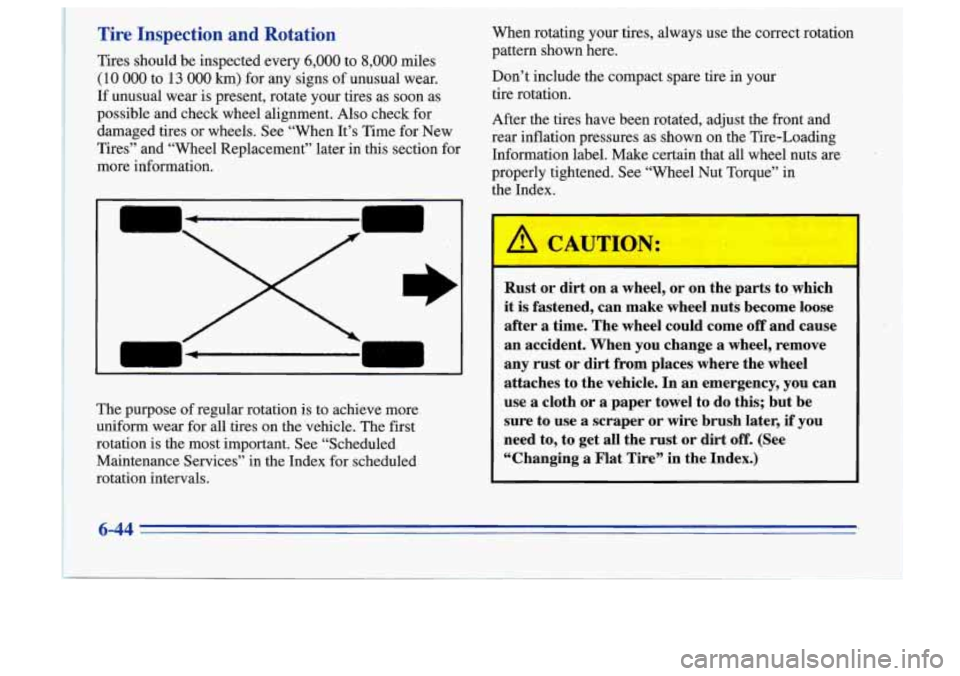
~ - ~~~~~ ~~ ~~~
~ ~
~ ~~~~~ ~~ ~ -
Tire Inspection and Rotation
Tires should be inspected every 6,000 to 8,000 miles
(10
000 to 13 000 km) .for any signs of unusual wear.
If unusual wear is present, rotate your tires as soon as
possible and check wheel alignment. Also check for
damaged tires or wheels. See “When It’s Time for New
Tires” and “Wheel Replacement” later in this section for
more information.
- ~ ~~ ~~ ~~ ~ ~~ ~ ~~~~~ ~~~ ~
When rotating your tires, always use the correct rotation
pattern shown here.
Don’t include the compact spare tire in your tire rotation.
After the tires have been rotated, adjust the front and
rear inflation pressures as shown on the Tire-Loading Information label. Make certain that all wheel nuts are
properly tightened.
See “Wheel Nut Torque” in
the Index.
The purpose of regular rotation is to achieve more
uniform wear for all tires on the vehicle. The first
rotation
is the most important. See “Scheduled
Maintenance Services” in the Index for scheduled
rotation intervals.
A CAUTI, :
Rust or dirt on a wheel, or on the parts to which
it is fastened, can make wheel nuts become loose
after
a time. The wheel could come off and cause
an accident. When you change
a wheel, remove
any rust or dirt from places where the wheel
attaches to the vehicle. In an emergency, you can
use
a cloth or a paper towel to do this; but be
sure to use a scraper or wire brush later, if you
need to, to get all the rust or dirt
off. (See
“Changing a Flat Tire” in the Index.)
6-44
Page 324 of 356

1 Long Trip/Highway Maintenance Schedule I
97,500 Miles (162 500 km)
0 Change engine oil and filter (or every
12 months, whichever occurs first).
17 Lubricate steering ball joints (or every
6 months, whichever occurs first).
0 Rotate tires. See “Tire Inspection and
Rotation” in the Index for proper rotation
pattern and additional information. During
tire rotation, check brake calipers for
freedom of movement. Refer to the
appropriate
GM service manual for proper
caliper service procedures.
An Emission Control Service.
DATE ACTUAL MILEAGE SERVICED BY.
100,000 Miles (166 000 km)
Drain, flush and refill cooling system
(or every
60 months since last service,
whichever occurs first). See “Engine
Coolant’’ in the Index for what to use.
Inspect hoses. Clean radiator, condenser,
pressure cap and neck. Pressure test the
cooling system and pressure cap.
An Emission Control Service.
Inspect spark plug wires.
0 Replace spark plugs.
An Emission Control Service.
An Emission Control Service.
I’
1”.